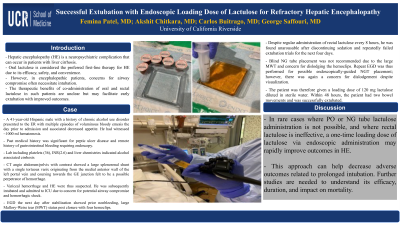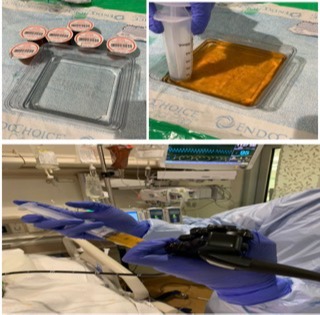Sunday Poster Session
Category: Liver
P1024 - Successful Extubation with Endoscopic Loading Dose of Lactulose for Refractory Hepatic Encephalopathy
Sunday, October 22, 2023
3:30 PM - 7:00 PM PT
Location: Exhibit Hall

Has Audio
- FP
Femina Patel, MD
University of California Riverside
San Bernardino, CA
Presenting Author(s)
Femina Patel, MD1, Akshit Chitkara, MD2, Carlos Buitrago, MD1, George Saffouri, MD1
1University of California Riverside, San Bernardino, CA; 2University of California Riversdie, San Bernardino, CA
Introduction: Hepatic encephalopathy (HE) is a neuropsychiatric complication that can occur in patients with liver cirrhosis. Oral lactulose is considered the preferred first-line therapy for HE due to its efficacy, safety, and convenience. However, in encephalopathic patients, concerns for airway compromise often necessitate intubation. The therapeutic benefits of co-administration of oral and rectal lactulose in such patients are unclear but may facilitate early extubation with improved outcomes.
Case Description/Methods: A 41-year-old Hispanic male with a history of chronic alcohol use disorder presented to the ER with multiple episodes of voluminous bloody emesis the day prior to admission and associated decreased appetite. He had witnessed ~1000 ml hematemesis. Past medical history was significant for peptic ulcer disease and remote history of gastrointestinal bleeding requiring endoscopy. Lab results indicated cirrhosis secondary to chronic alcohol use disorder. CT angio abdomen pelvis with contrast showed a large splenorenal shunt with a single tortuous varix originating from the medial anterior wall of the left portal vein and coursing towards the GE junction, (Fig-1)felt to be a possible perpetrator of hemorrhage. Variceal hemorrhage and HE were thus suspected. He was subsequently intubated and admitted to ICU due to concern for potential airway compromise and hemorrhagic shock. EGD the next day showed prior nonbleeding Mallory-Weiss tear (MWT) status post closure with four hemoclips. Despite regular administration of rectal lactulose every 8 hours, he was found unarousable after discontinuing sedation and repeatedly failed extubation trials for next four days. Blind NG placement was not recommended due to the large MWT and concern for dislodging the hemoclips. Repeat EGD was thus performed for possible endoscopically guided NG placement; however, there was again a concern for dislodgement despite visualization. The patient was therefore given a loading dose of 120 mg lactulose diluted in sterile water. Within 48 hours, the patient had two bowel movements and was successfully extubated.
Discussion: In rare cases where PO or NG tube lactulose administration is not possible and where rectal lactulose is ineffective, a one-time loading dose of lactulose via endoscopic administration may rapidly improve outcomes in HE. This approach can help decrease adverse outcomes related to prolonged intubation. Further studies are needed to understand its efficacy, duration, and impact on mortality.

Disclosures:
Femina Patel, MD1, Akshit Chitkara, MD2, Carlos Buitrago, MD1, George Saffouri, MD1. P1024 - Successful Extubation with Endoscopic Loading Dose of Lactulose for Refractory Hepatic Encephalopathy, ACG 2023 Annual Scientific Meeting Abstracts. Vancouver, BC, Canada: American College of Gastroenterology.
1University of California Riverside, San Bernardino, CA; 2University of California Riversdie, San Bernardino, CA
Introduction: Hepatic encephalopathy (HE) is a neuropsychiatric complication that can occur in patients with liver cirrhosis. Oral lactulose is considered the preferred first-line therapy for HE due to its efficacy, safety, and convenience. However, in encephalopathic patients, concerns for airway compromise often necessitate intubation. The therapeutic benefits of co-administration of oral and rectal lactulose in such patients are unclear but may facilitate early extubation with improved outcomes.
Case Description/Methods: A 41-year-old Hispanic male with a history of chronic alcohol use disorder presented to the ER with multiple episodes of voluminous bloody emesis the day prior to admission and associated decreased appetite. He had witnessed ~1000 ml hematemesis. Past medical history was significant for peptic ulcer disease and remote history of gastrointestinal bleeding requiring endoscopy. Lab results indicated cirrhosis secondary to chronic alcohol use disorder. CT angio abdomen pelvis with contrast showed a large splenorenal shunt with a single tortuous varix originating from the medial anterior wall of the left portal vein and coursing towards the GE junction, (Fig-1)felt to be a possible perpetrator of hemorrhage. Variceal hemorrhage and HE were thus suspected. He was subsequently intubated and admitted to ICU due to concern for potential airway compromise and hemorrhagic shock. EGD the next day showed prior nonbleeding Mallory-Weiss tear (MWT) status post closure with four hemoclips. Despite regular administration of rectal lactulose every 8 hours, he was found unarousable after discontinuing sedation and repeatedly failed extubation trials for next four days. Blind NG placement was not recommended due to the large MWT and concern for dislodging the hemoclips. Repeat EGD was thus performed for possible endoscopically guided NG placement; however, there was again a concern for dislodgement despite visualization. The patient was therefore given a loading dose of 120 mg lactulose diluted in sterile water. Within 48 hours, the patient had two bowel movements and was successfully extubated.
Discussion: In rare cases where PO or NG tube lactulose administration is not possible and where rectal lactulose is ineffective, a one-time loading dose of lactulose via endoscopic administration may rapidly improve outcomes in HE. This approach can help decrease adverse outcomes related to prolonged intubation. Further studies are needed to understand its efficacy, duration, and impact on mortality.

Figure: Figure illustrating lactulose administration during endoscopy procedure.
Disclosures:
Femina Patel indicated no relevant financial relationships.
Akshit Chitkara indicated no relevant financial relationships.
Carlos Buitrago indicated no relevant financial relationships.
George Saffouri indicated no relevant financial relationships.
Femina Patel, MD1, Akshit Chitkara, MD2, Carlos Buitrago, MD1, George Saffouri, MD1. P1024 - Successful Extubation with Endoscopic Loading Dose of Lactulose for Refractory Hepatic Encephalopathy, ACG 2023 Annual Scientific Meeting Abstracts. Vancouver, BC, Canada: American College of Gastroenterology.
